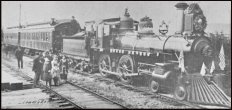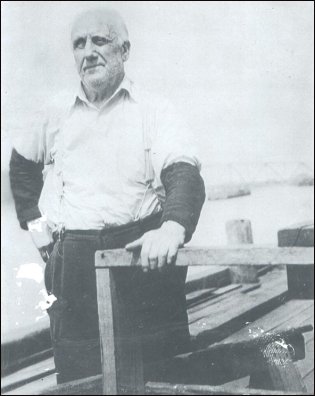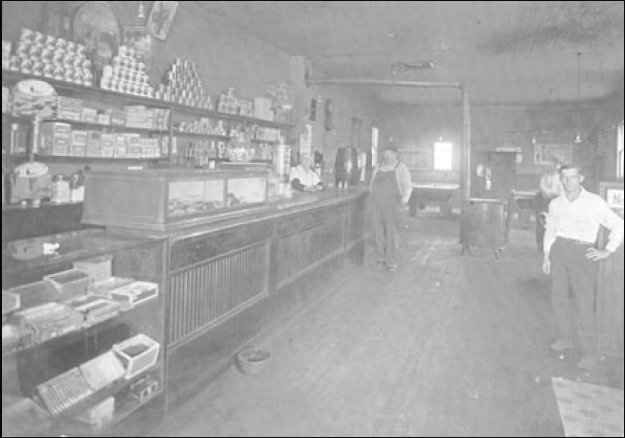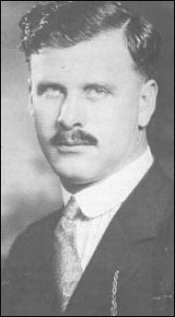Celebrating 3+ years on the web and passed 150,000 page views in May 2004
This is a page from our Subscribers Edition. Our free site remains free. How to subscribe to our separate online magazine or donate to our project
|
of History & Folklore
Subscribers Edition Stories & Photos
|

|
Covers from British Columbia to Puget sound. Counties covered:
Skagit, Whatcom, Island, San Juan. An evolving history dedicated
to the principle of committing random acts of historical kindness
Noel V. Bourasaw, editor  810 Central Ave., Sedro-Woolley, Washington, 98284 810 Central Ave., Sedro-Woolley, Washington, 98284
Home of the Tarheel Stomp  Mortimer Cook slept here & named the town Bug Mortimer Cook slept here & named the town Bug
|

|
James Cochrane, logjam volunteer
& Hamilton and LaConner pioneer
Illustrated history of Skagit & Snohomish Counties, 1906, page 808-09
 |
James Cochrane
|
James Cochrane, a general farmer residing a short distance east of Hamilton, was one of the men who arrived early in Skagit county. Those who realize the great work that he and his associates did when they cut a channel through the mighty logjam at Mount Vernon, consider them the lasting benefactors of the hustling communities that since have gathered along the Skagit. These pioneers, without capital and with their own hands, removed this historic dam, which a government agent had estimated could not be taken out for less than $100,000.00. Mr. Cochrane and associates undertook to free the river of this gigantic obstruction, which had been gathering for a hundred years before the first white man entered the valley. It was a tremendous undertaking, but these strong young men succeeded, in spite of the ridicule of the settlers, who said it could not be done. Mr. Wilson mortgaged some lots in Seattle and purchased flour for the men when they commenced work. They hoped to sell the logs for enough to pay them handsomely for their work, but in this they were disappointed. The jam was composed of big trees which had floated down the river in high water and had become interlocked in a solid mass some places fourteen feet high and extending more than a mile up the stream. Some places trees a foot in diameter grew on top of the jam. The men, with their saws, cut a channel 150 feet wide and about a mile long through the jam. The obstructions were removed by the peavey and the saw, there being no donkey engines in those days. James Cochrane worked 32 months in this enterprise and Mr. McDonald three years.
Mr. Cochrane was born in Edinburgh, Scotland in 1846, the son of Francis Cochrane, foreman of a dye establishment in Paisley, and later one of the first men to go to the diamond fields of South Africa. Mrs. Catherine (Campbell) Cochrane, the mother, was a native of Scotland who immigrated to the United States; she died at her son s place on the Skagit in 1897. Mr. Cochrane as a lad lived in both Scotland and England, but at the age of twelve years started out for himself, working on steamers plying between Scottish and English ports for four years. He then came to the United States during the days of the Civil War and was on the Orient, engaged in traffic for the North, when she was chased by a Southern privateer. Mr. Cochrane made several trips between New York and Liverpool in the interests of Northern merchants during the war.
He continued to follow the sea until 1869, traveling to South Africa in 1867 on a vessel loaded with troops and wool. He also was quartermaster on an English vessel in the expedition to Abyssinia. In 1869 he landed in San Francisco and a year later came to Seattle, then only a small place. He passed some time on Whidby [Whidbey] island, but came to Skagit county in the winter of 1871-2 and engaged in logging with [Joseph] F. Dwelley of LaConner on the flats where now are located some of the richest farms in the county. He passed some time in Snohomish county and it was there that he fell in with the proposition to clear the Skagit river of its famous jam. After that work was completed, he went to logging on Freshwater slough, below Mount Vernon, becoming one of the first to put logs into the Skagit river. He later started a camp above Mount Vernon and was with Harry Clothier when that town was started helping build the first structure there, Mr. Bryson's dwelling house. Mr. Cochrane followed logging on the Skagit for nine years. At one time he took up script land near the city of Mount Vernon, but later he sold this and in 1883 he located his present place as a homestead. Upon it he has ever since resided.

|
This photo is of the interior of James Cochrane's pool hall in LaConner, where he also dispensed cigars and confections. Pool halls became even more popular during Prohibition days. Saloons that had been dispensing spirits over the counter before Jan. 1, 1916, began dispensing pool balls. Occasionally, spirits would be found underneath the counters. All these photos are from a Cochrane granddaughter, Marilyn Studley.
|
[On July 25, 1886] Mr. Cochrane married Miss Mary J. [Cary], a native of Indiana and daughter of Alfred and Dorcas (Wood) Cary, who came to this county in 1875, having been preceded by their sons, Aaron, Freeman and Jesse, in 1874. [The Cochranes married at the home of Jesse Cary, east of Hamilton.]
Mr. and Mrs. Cochrane have eight children: Colin C. studying practical engineering in electrical shops in Seattle, Robert C., Charles A., Anna, Janet, George Dewey, Frances and Florence. Mr. Cochrane is a member of the Foresters; also of the Red Men, and in politics he is a Republican, active in the work of the party, attending conventions and participating in their deliberations. He has been a member of the school board for many years and was one of the prime movers in behalf of the high school for Hamilton, also was on the board when the school house was built, lending his influence toward making it one of the best equipped houses of its kind in the county. Mr. Cochrane has a farm of sixty-five acres in his home place, and has twenty-four acres of farmland in addition, also 170 acres of timberland in Snohomish county, and houses and lots in Hamilton. At one time of his life he was interested in mining and in the Ruby Creek excitement took the first pack train into the camp. He and his partners were the only ones to develop their prospect openings to bedrock; mineral in paying quantities was not uncovered, and hence the venture proved a failure.
 |
George Dewey Cochrane
|
Mr. Cochrane then went to the Fraser river gold fields [1858, same time as Mortimer Cook of Sedro and Cap Warner of Prairie], where he spent one year operating a tugboat. He has ever been an aggressive character, and is one of the staunch pioneers to whom the present residents of Skagit county are greatly indebted. Without such men to "blaze the trails" and surmount the prodigious obstacles placed in the way of progress by the forces of nature and the savage aborigine, conditions in the Northwest would not be what they are today, and the boundaries of civilization could never be extended with the rapidity characteristic of the last quarter of a century.
Skagit River Journal research about James Cochrane
We have long admired James Cochrane because he was among the first to respond when his fellow settlers needed a hand. That was one of the most admired traits on the frontier. We are indebted to his granddaughter, Marilyn Studley, who has been unearthing material about him and who transcribed this profile from the Illustrated History of 1906, the bible of local history. She welcomes any inquiries or further information about her family or the early days of Hamilton. Her email is: res078qm@gte.net.
Marilyn also provided some more information about her family, in addition to the notes in brackets in the story above. After a long search, she discovered that her father was buried in the Hamilton cemetery on Dec. 5, 1927. She thanks Mrs. Mellis and also Lemley Mortuary of Sedro-Woolley for tracking down the information. He was not buried in the family plot because it was full. Her grandmother, Mary Cochrane, died on March 18, 1908, after the above profile was published. Mary's birth and death information, along with that for many other pioneers, is included in this marvelous Rootsweb.com genealogy site. She also discovered that her great grandmother, Catherine Anne Campbell Cochrane, was born in Glasgow, Scotland, on August 15, 1818 and died May 30 1897. She was buried in the family plot in the Hamilton Cemetery. During the research, she found a nine Cochrane child, Ellen, the second youngest daughter. Marilyn's father was George Dewey Cochrane. When we researched Hamilton burial records, we found a real corker. James's father, Francis, born June 5, 1802, died June 10, 1912, at age 110 years. He must have been the oldest resident in the area at the time. We have been unable thus far to establish the relationship between James and William Cochrane, who was a major hop grower and dairy farmer near Orillia and was sheriff of King county in the late 19th century.
Details of the Mount Vernon logjam
We learn from other sources that the first of the series of efforts on the part of the people of the Skagit to secure the removal of drift and jams from the Skagit river seems to have been instituted in earnest in the year 1878, a year after the town of Mount Vernon was born. A formal petition was presented to congress at that time asking for an appropriation of twenty-five thousand dollars for the purpose of improving the river. The government agent estimated the probable expense of the work at a $100,000.00.
A company was organized to complete the task of removing the jam when the state could not help finance the project. They consisted of: James Cochrane, Donald McDonald, Marvin Minnick, Joe Wilson, John Quirk, Daniel Hines, Fritz Dibbern and Dennis Storrs. Wilson and McDonald were the original promoters. To raise money for starting their undertaking, Wilson and McDonald mortgaged two lots in Seattle belonging to Mr. Wilson. The others joined at various times in the enterprise. Their first theory was to reimburse themselves by the sales of the logs that would be loosened from the jam, but the logs proved to be so badly strained by the pressure that they did not yield much merchantable timber.
Another proposed improvement allied to the removal of the big jam was the building of a levee along the north side of the Skagit river from the Sound waters to the head of the jam. This improvement would be practicable if the jam were removed. It was estimated at the time that the total cost of the proposed levee would not exceed $10,000.00 but this proved to be a gross underestimate, as the work is not yet completed and the $10,000.00 has proved but a drop in the bucket.
The great jam consisted of two divisions, the lower beginning at the old Kimble homestead below Mount Vernon and extending up the river to a point about opposite the present Kimble residence, a distance of perhaps half a mile. The upper part of the jam was considerably larger, beginning about half a mile above the upper end of the lower jam and extending over a mile. The lower one was believed to be at least a century old and was probably much older, while the upper one was to all appearance of comparatively recent formation. It was increasing in size very rapidly. Dennis Storrs stated that within three years after his arrival a quarter of a mile of debris had accumulated at its upper end. Beneath and between the tangled mass of debris the river was obliged to force its passage and in places beneath the lower jam there were twenty-four feet of water at the lowest stage. The material of the jam was mainly green timber, but in many places sediment had accumulated to such an extent as to permit the growth upon it of a perfect jungle of brush and even of large trees. At many points, often concealed from the view of the explorer by brush, there were open shoots into the sullen treacherous depths below. David E. Kimble that on one occasion while he was at work on the jam with others, one of the party suddenly disappeared into one of those holes. The other men rushed as rapidly as possible to a larger expanse of water some distance below, but Mr. Kimble, remembered a small opening between the trees nearer by, hastened to it. Just as he reached it he saw an agitation of the debris at the place and thrusting his arm into the water he grasped the struggling man and succeeded in rescuing him from death.
Not only was the big jam a great impediment to navigation, but it was also a continual menace to the fields and stock and buildings of the settlers on the lowlands on either side of the river. On account also of the great difficulty of making roads through the forest this impediment to river communication almost prevented settlement at points on the river above; furthermore, the removal of the jam the sine qua non of the lumber industry above it. The scanty resources of the early settlers seemed to forbid their carrying the task to completion but they made most energetic, even heroic and finally successful efforts to meet the emergency. After nearly a year the men had removed nearly a half-mile of the jam and had reduced the portage distance one and one half miles. They were compelled to cut through from five to eight tiers of logs, which generally ranged from three to eight feet in diameter, representing a total cutting out of a space thirty feet deep.
This story was featured first in Issue 5 of our separate online subscriber-paid magazine, now in Issue 20. If you are not a subscriber, read details of how to subscribe here.
Story posted on Oct. 9, 2001, and last updated on June 12, 2004
Please report any broken links or files that do not open and we will send you the correct link. Thank you.
|
You can read about our prime sponsors:
Read the history websites of our two newest sponsors and supporters:
Oliver Hammer Clothes Shop at 817 Metcalf street in downtown Sedro-Woolley, 82 years
Bus Jungquist Furniture at 829 Metcalf street in downtown Sedro-Woolley, 36 years
Peace and quiet at the Alpine RV Park, just north of Marblemount on Hwy 20
Park your RV or pitch a tent by the Skagit river, just a short driver from Winthrop or Sedro-Woolley
College Way Antique Mall, 1601 E. College Way, Mount Vernon, WA 98273, (360) 848-0807
Where you will find wonderful examples of Skagit county's past, seven days a week
North Cascade Ford, formerly Vern Sims Ford Ranch,
West Ferry street and Crossroads/Highway 20
either on the Sedro-Woolley page or directly at www.northcascadeford.com
DelNagro Masonry Brick, block, stone — See our work at the new Hammer Heritage Square
See our website www.4bricklayers.com
33 years experience — 15 years as a bonded, licensed contractor in the valley
Free estimates, reference, member of Sedro-Woolley Chamber  (360) 856-0101 (360) 856-0101
|
|
|
Did you find what you were looking for? If not, please email us and tell us what you seek and we will put it on our list to research. The more details, the better.
|
Please sign our guestbook so our readers will know where you found out about us, or share something you know about the Skagit River or your memories or those of your family. Share your reactions or suggestions or comment on our Journal. Thank you for taking time out of your busy day to visit our site.
|
Sign Our Guestbook

View Our Guestbook
|
Remember, we welcome correction and criticism. Please click on the email slot at the right to report any problems with these pages or to suggest ideas for future stories. This is a completely free site. We fund it by providing an online magazine for paid subscribers. If you are not already a subscriber and you would like to help support our considerable research costs, you can subscribe for just $20.00 per year. As a paid subscriber, you will receive eight yearly issues plus many rare treats between times, including scans of photos and documents that illustrate local history, before they are shared with anyone else. You can go here for Subscription details and you can read the preview edition to see examples of our in-depth research. You may also order gift subscriptions for friends, family or clients who are interested in local history or students or military people who are away from home. Or you can email us for more details. Do you have scanned photos to share? Or you can mail us copies. See addresses to right.
|
Email us at: journal@stumpranchonline.com

Mail copies/documents to street address: Skagit River Journal, 810 Central Ave., Sedro-Woolley, WA, 98284.
|
Skagit River Journal free resources home page
If you are not a subscriber, go to story list of the Skagit River Journal subscriber edition,
including all archives.
Skagit River Journal online subscriber edition Preview edition page





 (360) 856-0101
(360) 856-0101